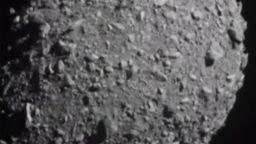Editor’s Note: Sign up for CNN’s Wonder Theory science newsletter. Explore the universe with news on fascinating discoveries, scientific advancements and more.
NASA has rolled the massive Artemis I mega moon rocket back into its hangar, called the Vehicle Assembly Building, at Kennedy Space Center in Florida to protect it from Hurricane Ian.
The move, which concluded at 9:15 a.m. ET Tuesday, delays the third launch attempt for the Artemis I mission, which is slated to send an uncrewed capsule around the moon, for at least a few weeks.
“Managers met Monday morning and made the decision based on the latest weather predictions associated with Hurricane Ian, after additional data gathered overnight did not show improving expected conditions for the Kennedy Space Center area,” NASA noted on its Artemis blog.
The rocket, called Space Launch System or SLS, made the 4-mile (6.4-kilometer) slow trek back to the maintenance building starting at 11:21 p.m. ET on Monday.
“The decision allows time for employees to address the needs of their families and protect the integrated rocket and spacecraft system. The time of first motion also is based on the best predicted conditions for rollback to meet weather criteria for the move,” NASA said.
The overall goal of NASA’s Artemis program is to return humans to the moon for the first time in half a century. And the Artemis I mission — which is expected to be the first of many — will lay the initial groundwork, testing the rocket and spacecraft and all its subsystems to ensure it’s safe enough for astronauts to fly.
But getting this first mission off the ground has proven to be a trying endeavor. The agency had already decided over the weekend to postpone the third launch attempt, which was previously scheduled for Tuesday, September 27, due to weather concerns. The question going into Monday morning was whether the mission team would need to roll the rocket back to shelter as Hurricane Ian headed toward Florida.
With that decision made, NASA focused on getting the roughly $4 billion SLS rocket back to the nearby Vehicle Assembly Building, a massive structure large enough to house the vehicle as it sits upright. The rocket made the trip by slow crawl, riding atop a moving platform named the Crawler-Transporter 2.
Technical issues thwarted the first two attempts to get the SLS rocket off the ground for the Artemis I mission. A main challenge was a series of leaks that sprung up as teams attempted to fill the rocket with super-chilled liquid hydrogen fuel. The mission team worked to troubleshoot those issues and ran a test last week. Though the tests didn’t go exactly according to plan, NASA deemed it a success, saying it “accomplished all our primary objectives.”









